Tagged With ‘Chanel’
Chanel
Pour Monsieur
7 July, 2015
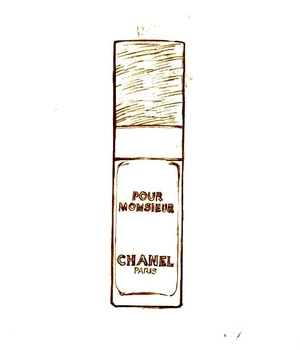 I’ve loved Pour Monsieur for decades now, so it was a bit of a surprise when I realised that I hadn’t reviewed it up till now. But actually I think that tells you something about the fragrance itself, which is so discreet that it’s all too easy to overlook – and that’s a real shame, because it’s a wonderful thing.
I’ve loved Pour Monsieur for decades now, so it was a bit of a surprise when I realised that I hadn’t reviewed it up till now. But actually I think that tells you something about the fragrance itself, which is so discreet that it’s all too easy to overlook – and that’s a real shame, because it’s a wonderful thing.
Pour Monsieur smells softly spicy when you first spray it on, but soon you also start smelling its mossy, herbaceous base. The spiciness comes partly from cardamom, and the woodiness is a mixture of oakmoss (actually a type of fragrant lichen) with tiny amounts of cedarwood, resinous labdanum (a kind of cistus) and earthy vetiver.
Chanel’s first modern men’s fragrance, it was conjured up by the perfumer Henri Robert and launched in 1955. Robert, who was born in 1899 and died in 1987, took over at Chanel after the retirement of the legendary Ernest Beaux, and went on to launch Chanel No19 in 1970 and Cristalle in 1974.
Pour Monsieur is one of the best examples of the perfume style or ‘family’ known as chypre, which derives from the French for Cyprus (the island rather than the tree), presumably inspired by the scent of Mediterranean herbs and shrubs baking in the sun. The basic combination – first popularised by François Coty in a 1917 perfume of the same name – combines bergamot, oakmoss and labdanum.
There have been endless variations on the theme since, but few of them match Pour Monsieur for sheer class; even its packaging is beautifully cool. Though it’s not an expensive perfume, it is redolent of luxury in its quiet complexity, like the deceptively simple face of a Patek Philippe watch. This is insider luxury, if you like, which is all about discretion and restraint rather than ostentation and excess.
The upside – in a perfume or a Patek Philippe – is that not everyone will recognise what you’re wearing. And while Pour Monsieur lasts a long time on the skin, it’s one of those fragrances that doesn’t carry far, so if you’re looking to impress it probably isn’t for you. But if wearing something wonderful makes you feel more self-confident and assured, then I can think of few better perfumes to buy.
Knize
Knize Ten
8 May, 2015
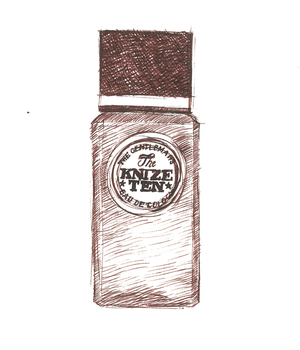
The year 1924 was a great one for perfume, if only because it saw the launch of both Chanel’s sumptuous Cuir de Russie and this, the wonderful Knize Ten. That both have survived into the present day is a bit of a miracle, but though they’re both usually placed in the ‘leather’ category of fragrances, they could hardly be less similar.
Cuir de Russie is a wonderfully rich and complex perfume, but its oddly androgynous combination of smoke and leather with a heavy floral note can make it rather difficult to wear. Knize Ten is a much more immediately appealing, fresher-smelling scent, and its leatheriness is tempered with the kind of zesty and herbal ingredients you’d expect to find in a classic eau-de-cologne – things like bergamot, lemon and geranium.
These gradually fade away on the skin, leaving a lovely, long-lasting but not overpowering leathery scent, less smoky than it is sweet. To me it also has a strong whiff of heliotrope – those electric-blue park bedding plants whose cherry-pie scent can be so intoxicating on a hot still high-summer’s day – but others may detect more than a hint (if I remember it right) of Plasticine; not unpleasant in itself, but enough to add a touch of childhood to the mix.
If Cuir de Russie is a testament to the genius of Ernest Beaux (whose greatest triumph was Chanel No 5), then Knize Ten is a fitting monument to François Coty (the mass-market perfume pioneer) and his brilliant technical director, Vincent Roubert (who had previously worked with Ernest Beaux in Grasse, then the perfume capital of France). It was commissioned, rather unusually, by a bespoke men’s tailoring company from Vienna, Knize, whose boutique is still going strong today. I’d wondered whether Knize Ten was the sole survivor of nine other fragrances, but it turns out that the name was dreamed up by their advertising director of the time, who beat Ralph Lauren by at least 50 years by seeking to associate the company with the aristocratic imagery of polo: the name ‘Ten’ was chosen to reflect the highest handicap in the game.
I love everything about Knize Ten: not just its instantly appealing smell but the smart glass bottle, with its crisply bevelled corners and chunky black cube of a cap. I’ve read somewhere that, like the company’s Viennese store, it was designed by the legendary Austrian architect Adolf Loos, and although that seems like wishful thinking it could be true; Loos designed further shops for Knize in Paris and Berlin, so their association was obviously close, and the dates look perfectly plausible too.
Even the typography of the label – a bold slab serif in a Victorian playbill style – is punchy and confident, just like the perfume inside. And while it’s far less widely available than it deserves to be, it’s not even that expensive by contemporary standards: what’s not to like?
Slugs and snails and puppy-dogs’ tails
23 April, 2015
A while back I attended a perfume training day with Roja Dove, perfumer extraordinaire in several senses of the word. A small group of us smelled something like a hundred different perfume ingredients, from bergamot to tuberose (the pure extract of which smells far more refined than any of the so-called ‘tuberose’ perfumes I’ve sampled).
Lots of surprises: extract of daffodil smells like hay; galbanum like freshly-podded peas. Fine lavender oil has an oddly sweaty side to it, which I think is one of the things I smell in Guerlain’s legendary Jicky. Roja brings in beaver glands, which gave us the wonderful leathery smell of castoreum (used in Chanel’s Cuir de Russie), and the greasy scrapings from the Ethiopian civet cat, which has the farmyard reek of fresh cow-pats but – in minute quantities – adds a disquieting hint of sex to any perfume in which it (or its synthetic equivalent) is used.
It was a fascinating and really useful day, though it must take daily practise to memorise so many ingredients. What surprised me, though, was the imprecision of perfume terminology. Particularly extracts come from very specific sources: galbanum, for example, derives from the roots of particular species of Iranian fennel (Ferrula gummosa and Ferrula rubricaulis), yet in our training day it was vaguely described as coming from ‘an umbellifer root’. Given that there are over 3,700 individual species in the umbellifer family (now renamed the Apiaceae), that wasn’t much help – cow-parsley is an umbellifer too, but I bet its roots don’t smell like fresh peas.
And as for daffodil smelling like hay, I wanted to know which daffodil: there are between 30 and 70 species of narcissus (the Latin term for daffodil) and hundreds and hundreds of varieties, many of which smell very different from each other.
It struck me as an odd contrast between how incredibly precise perfume chemists have to be, describing specific fragrances down to the molecular level, and yet how imprecise so much perfume terminology seems to be at the same time. If perfumers themselves use such vague descriptions, is it any wonder that we, the perfume-buying public, find the subject so confusing and so hard to understand?
Sex and scentsibility
4 February, 2015
Are you man enough to wear Chanel No. 5? Or woman enough to splash on Azzaro Pour Homme? I have to admit that I’ve never been a great fan of cross-dressing, but it makes about as much sense to talk about ‘masculine’ and ‘feminine’ fragrances as it does to talk about ‘male’ or ‘female’ art, music or food. The fact that we divide perfumes into men’s or women’s fragrances has less to do with logic than it has to do with marketing, packaging and conventional thinking – and if you look back it’s not even that old a distinction.
Once upon a time, perfumes were perfumes, and there appears to have been little in terms of a gender divide until the early twentieth century. Men wore fragrances which today we’d regard as outrageously effete: both Napoleon and Wagner were famous for drenching themselves in scent, and Victorian gentlemen favoured sweetly scented floral perfumes alongside the ubiquitous eau de cologne. Even the words themselves – fragrance, perfume, scent – are genderless: the daft male-only term ‘after-shave’ appears only to have been dreamed up in the 1920s as a marketing wheeze. Though the expression may have made perfume sound a bit more butch and manly, all too often (in the days before male moisturiser became acceptable) it also left the more literal-minded chap with a burning face and peeling skin.
I’m not suggesting that male readers should rush out and purchase the olfactory equivalent of a pair of pink frilly knickers. Some scents (naming no names) are so insanely sweet and girly that it would be hard for even the most rugged male to get away with wearing them, but then they also tend to be the kind of perfume that smell as terrible on a grown woman as they would on any self-respecting man.
Beyond those parodies of perfume, there are remarkably few fragrances that, if you trust your nose and can brace yourself to ignore everything you’ve been told by breathless adverts and terrifyingly made-up sales assistants, are so incontrovertibly feminine or masculine as to be completely unwearable by either sex. Take one famous example. Christian Dior’s Eau Sauvage was launched in 1966 and quickly established itself as a hugely popular men’s fragrance. It’s stayed on the best-seller lists ever since, and I think most men would agree that there are few more bracing, fresh and (above all) masculine fragrances around.
I couldn’t agree more, but if you’re a fan of Eau Sauvage, next time you’re in a well-stocked perfume store, wander over to the women’s-perfume counter and have a smell of Diorella, launched just six years later and designed by the same perfumer, the legendary Edmond Roudnitska. The first time I smelled it I thought, ‘But this is Eau Sauvage!’ And it is, give or take some extra fruitiness which, you could say, gives it a slightly more girly character – though perfume guru Luca Turin regards it as ‘a perfected Eau Sauvage and one of the best masculines money can buy’.
In many ways it’s even easier the other way around, and women seem always to have been less inhibited about adopting fragrances that were originally intended to be for the opposite sex. Eau Sauvage is a classic example: whether they smelled it on their boyfriends or discovered it for themselves, women quickly recognised it as the masterpiece it is, and those in the know have been wearing it ever since. Guerlain’s superb Vetiver is, to my mind, one of the most archetypically masculine perfumes in existence, yet it, too, has long been a female favourite – the olfactory equivalent of an Yves Saint Laurent tuxedo.
More striking still are those fragrances that have crossed the gender divide more or less entirely. When Aimé Guerlain launched Jicky in 1889, it was initially bought by men; at the time its sharp, slightly catty smell was considered too overtly sexual in character for respectable women to risk wearing it. By the 1920s, though, liberated by the rise of female emancipation, women started using Jicky too, and gradually it became a ‘female’ fragrance – though a few self-confident men (Sean Connery being the most often-cited example) continue to wear it today. Chanel’s super-plush Cuir de Russie followed a similar trajectory, though it would be hard, even now, to define it as either masculine or feminine in character.
Visit the standard-issue perfume store and you’d be forgiven for thinking that we were still stuck in a world where men were men and women were women and never the twain should meet, as if history – in the world of perfume at least – had got stuck around 1955 and all the social and sexual revolutions since then had never actually happened. But society, of course, has changed, and there are encouraging signs that at least parts of the perfume industry have begun to realise that dividing fragrance along crude gender lines is a weirdly outdated thing to do. A handful of future-looking perfume brands, such as Byredo, Comme des Garçons and Escentric Molecule, already offer ‘genderless’ fragrances, and there is a growing trend for imaginative retailers to follow their lead, stocking perfumes by brand instead of dividing them into men’s and women’s scents.
Perfume customers are changing too. The majority of people may continue (for the moment at least) to accept the status quo, but for the small but growing band of perfume-lovers who are happy to think for themselves, choosing perfume on the basis of its supposed masculinity or femininity has come to seem increasingly outmoded. The trick is simply to follow your nose: to choose the perfumes you love, like the people you love, regardless of what other people might say.
Chanel
Antaeus
8 December, 2014
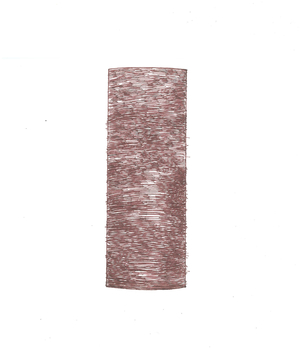 When I first started thinking about The Sniff Box, I wondered how I could make it look different from other perfume blogs. I knew I’d have no problem with the overall look, thanks to my super-talented friend, Leanda Ryan, whose design perfectly reflects the idea of ‘perfume in plain English’.
When I first started thinking about The Sniff Box, I wondered how I could make it look different from other perfume blogs. I knew I’d have no problem with the overall look, thanks to my super-talented friend, Leanda Ryan, whose design perfectly reflects the idea of ‘perfume in plain English’.
But illustrating individual perfumes is a problem, as you’ll gather if you look at other perfume sites on the interweb. The obvious thing to do is to use a ‘pack shot’, generally supplied by the brand in question: it’s what the brands like as that’s how they want you to see their scent, but how many times do you want to see the same cheesy photograph?
The trouble is, if you don’t use a photo of the bottle, what can you use instead? How do you illustrate something you can smell but can’t actually see? It’s interesting to check out what other people come up with, but given that few bloggers can afford to commission photography or illustration, they’re generally stuck with stock shots of things like perfume ingredients – a sprig of lavender, say, or a twist of lemon – which are as cheesy as the pack shots they’re trying to avoid.
It took a while, but finally it struck me: since I can draw, after a fashion, why not draw my own illustrations? And that’s how I began.
All of which is a roundabout way of saying that, when I was trying to draw my bottle of Antaeus this morning, it gradually dawned on me that it is one of the most beautiful perfume bottles I know. It’s also one of the simplest: a tall, square, black-glass container that, if you took away the classy sans-serif Chanel lettering, would bear a more-than-passing resemblance to sinister monolith in 2001: A Space Odyssey.
Designed (or at least commissioned) by Chanel’s long-standing artistic director, Jacques Helleu, and launched in 1981, Antaeus was a kind of dark-side twin to the brand’s only other men’s fragrance at that time, Pour Monsieur (launched way back in 1955). Their bottles may be almost identical in shape, but Pour Monsieur is as cool and transparent as Antaeus is brooding and mysterious, and that reflects the fact that they’re very different scents.
Pour Monsieur is a refined, impeccably discreet fragrance: perfect in its way but perhaps (dare one whisper it?) just a tiny bit dull. Antaeus, by contrast, is a dark sexy scent that was launched just as the disco era crashed and burned: the same year Ian Schrager and Steve Rubell sold out of Studio 54 and the big disease with a little name first reared its ugly head.
Antaeus (the scent) was created by Chanel’s much-fêted in-house perfumer, Jacques Polge, in collaboration with François Damachy, now head of fragrance at Dior). As suggestive as Pour Monsieur is safe, its sexiness comes from castoreum, derived from a secretion extracted from beaver wee (I kid you not), which despite its revolting origins becomes, after careful treatment, a potent perfume ingredient, with its musky, leathery smell.
It’s a warm, slightly spicy leather scent, with a lot of Mediterranean herbs, most notably clary sage and thyme, that most of us would probably associate with hot, rocky mountainsides in southern France and Greece. My nose isn’t yet sensitive enough to identify them, but it also apparently contains labdanum (derived from two different species of Cistus, another Mediterranean shrub), as well as sandalwood and patchouli, which presumably add to the slightly hippyish warmth of the scent.
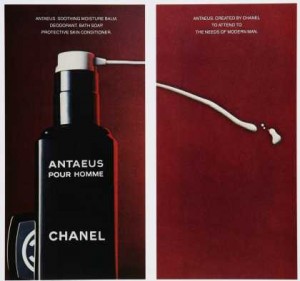 Antaeus became a big best-seller in the early 1980s initially, it seems, among gay men, and with its hints of sex and leather it’s easy to see why. Chanel itself tapped into this trend in 1983 with a delightfully pervy advert (pictured), whose subtext I can leave to your imagination.
Antaeus became a big best-seller in the early 1980s initially, it seems, among gay men, and with its hints of sex and leather it’s easy to see why. Chanel itself tapped into this trend in 1983 with a delightfully pervy advert (pictured), whose subtext I can leave to your imagination.
But gay men, as we’ve often been told, are classic early adopters, and these days Antaeus is just as likely to attract anyone who enjoys a rich and complex scent. It’s long been one of my favourites, for its warmth and easy appeal, but I love its darker origins too: sex (and history) in a bottle.
Chanel
Cuir de Russie
23 November, 2014
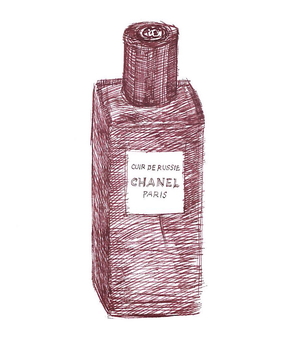 Would you smear yourself with diluted tar? That’s my first question. My second question: would you pay £150 or more to smear yourself with diluted tar? If your answer to either (or both) of these questions is ‘Not on your nelly’, then it’s possible that Cuir de Russie is not for you. If, on the other hand, you have an adventurous spirit and an interest in history, read on.
Would you smear yourself with diluted tar? That’s my first question. My second question: would you pay £150 or more to smear yourself with diluted tar? If your answer to either (or both) of these questions is ‘Not on your nelly’, then it’s possible that Cuir de Russie is not for you. If, on the other hand, you have an adventurous spirit and an interest in history, read on.
Chanel’s Cuir de Russie is widely regarded as one of the most luxurious perfumes you can buy, and there are good reasons for that. It’s one of the perfumes in Chanel’s Les Exclusifs range, all of which use the highest-quality raw materials. And it was concocted – at least in its original form – by Ernest Beaux, the perfumer whose name should really be on every bottle of Chanel No5, since it was Beaux, not Coco Chanel, who created it.
But back to tar. Tar comes in many forms, the best-known being bitumen or asphalt, the stuff that binds road surfaces together and sticks to your shoes in hot weather. You wouldn’t want to dab yourself with bitumen, not least because it smells revolting, but other kinds of tar are a different matter.
Burn wood in the absence of air and you get charcoal, but do the same to the papery sheets of bark that peel off silver birch trees, and out oozes a sticky black gloop with a rich smoky smell. This dense chemical mix of hydrocarbons and phenols is known as rectified birch tar, and it’s packed with delicious molecules such as guaiacol, cresole, catechol, pyrogallol and 5-methyl-pyrogallol dimethyl ether.
In Russia, which has no shortage of birch forests, birch tar became an important export product from the sixteenth century on. It had many uses, not least as an all-purpose glue, but the reason I’m writing about it now is because of the discovery that, if freshly tanned cowhide was impregnated with birch-tar oil, the resulting leather was not only waterproof and mould-resistant, but also developed an extremely pleasant smell.
Russian leather – or cuir de Russie, as it was known in France – gained an unrivalled reputation for quality, especially at the luxury end of the market. Ernest Beaux, who was born in Moscow and followed his brother into a job at the imperial perfumers, Rallet & Co, would have discovered the alluring smell of tar-impregnated leather early on, and it must have carried nostalgic memories for him when he left Russia for Paris in the wake of the Revolution.
The relentlessly social-climbing Gabrielle Chanel, for her part, had a Russian connection of her own: Grand Duke Dmitri Pavlovich, one of Rasputin’s assassins, with whom she had a short affair in 1920-21. It was through Pavlovich that Beaux first met Chanel, but which one of them came up with the idea of a perfume called Cuir de Russie isn’t clear. It was launched in 1924, three years after No.5, and was worn, from the first, by both women and men.
Though the use of rectified birch tar in perfumery is now restricted in the EU, and Cuir de Russie was ‘reorchestrated’ (for which read ‘reformulated’) by Chanel’s in-house perfumer Jacques Polge in 1983, it is still, it’s said, a fair approximation of Ernest Beaux’s original scent, though perhaps a little less rough-edged than the original.
Whatever the truth – and truth is a vanishingly rare commodity in the perfume industry – it’s still a wonderful smell, smoky and leathery and smooth, with no single ingredient taking centre stage. Beaux added aldehydes (the chemicals that give No.5 its glittery zing) but Cuir de Russie also includes jasmine, iris, sandalwood and rose, among other luxurious things, and it’s this balance of ‘masculine’ and ‘feminine’ scents that make it both immensely alluring and oddly difficult to place.
If ever a perfume was androgynous, then Cuir de Russie is it. Though I’m a great fan of ambiguity, and I certainly appreciate its sheer, unadulterated luxury, I have to admit that its mix of masculinity and femininity, powdery sweetness and smoky bitterness, does sometimes make it rather hard to wear. Still, it’s wonderfully long-lasting, without being overpowering, and for an expensive scent that’s surely a good thing (though as it comes in a stonking 200ml bottle, Cuir de Russie is actually better value than a lot of supposedly ‘cheaper’ perfumes). As for whether I’d wear diluted tar, I think the answer is yes.
Chanel
Egoïste
22 July, 2014
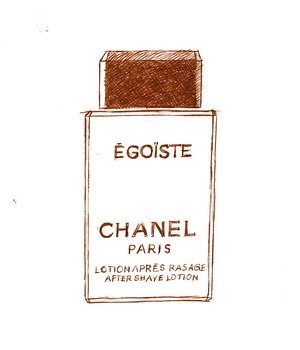
The first thing I think when I smell Egoïste is ‘spicy!’ It’s a big, bold, in-your-face fragrance, well-suited to its name, which doesn’t suit everyone – in fact I’ve never thought it really suited me. But if you have the confidence to carry it off it’s a superb perfume of its kind.
Egoïste was created by Chanel’s long-standing in-house perfumer, Jacques Polge, and released in 1990 with the kind of blitzkrieg advertising that Chanel does so well. Possibly too well, since I suspect that fewer people remember the perfume than Jean-Paul Goude’s brilliant film, in which a bevy of deranged-looking models screamed ‘Egoïste!’ while slamming open and shut the blinds of a scaled-down version of the Hôtel Carlton in Cannes.
But back to the perfume. The spiciness of Egoïste is of the sneeze-inducing peppery kind, and for a long time I assumed it was just that – black pepper, mixed with the scents of (among other things) rose, vanilla and sandalwood. But looking at the ingredients again I wonder if at least some of the pepperiness actually comes from carnation – not the scentless supermarket kind but those wonderful old-fashioned ‘clove-scented’ carnations, which have an intoxicating, slightly peppery smell all their own.
The reason I rarely wear Egoïste, though, is less to do with its pepperiness than with another of its main ingredients: vanilla. I’ve no doubt that Chanel uses only the finest quality vanilla in its perfumes, but it’s simply not a smell that – in fragrances, at least – I particularly like. Part of the problem is that, for a while, vanilla was so widely used in perfumes aimed at young women, with the result that (to me at least) it smells too sweet and teenage-girly. And it’s such a foody smell as well: I love what vanilla does to chocolate, but I’m not sure I want to wear it on my skin.
Still, like any work of great skill, I admire its artistry, even if it doesn’t seem to suit me. If you haven’t already tried it then give it a go and see if it works for you.
Hermès
Equipage
14 July, 2014
 Equipage is a perfume I hadn’t smelled for years. I had a bottle long ago, but when it ran out I never got round to replacing it. Actually I’d forgotten how good it smells, so I’m delighted to have it back. It’s as timeless and well made as a piece of Hermès saddlery, and it even has something of the same comforting, leathery smell.
Equipage is a perfume I hadn’t smelled for years. I had a bottle long ago, but when it ran out I never got round to replacing it. Actually I’d forgotten how good it smells, so I’m delighted to have it back. It’s as timeless and well made as a piece of Hermès saddlery, and it even has something of the same comforting, leathery smell.
The first Hermès perfume to be aimed at men, Equipage was created by Guy Robert, one of the leading perfumers of his generation. You could say that Robert had perfume in his blood. He learned his trade in Grasse, once the world capital of perfumery and still an important production centre today. His uncle, Henri Robert, succeeded Ernest Beaux as perfumer-in-chief at Chanel, where he created No.19 and Pour Monsieur.
Equipage shares much of its character with Pour Monsieur, smelling effortlessly grown-up, discreet and rather conservative. The funniest comment I’ve seen online is that it ‘makes you smell ten years older. Richer, maybe; but older’, and I think that’s right, but now I’m older myself it’s nice to at least smell rich.
For a men’s perfume it has rather more floral ingredients than one might expect, including lily of the valley, jasmine and carnation, but they’re so subtly blended together that you’d never know. The flowers give it a little sweetness, but that’s balanced by the spicy, clove-scented edge of carnation. Equipage also contains a lot of orange, in the form of bergamot, squeezed from the peel of the Sicilian bergamot orange, Citrus bergamia, which is also used to flavour Earl Grey tea.
But that’s not all. This rich and complex fragrance also includes oakmoss (or a synthetic equivalent), which is actually a type of lichen that smells like a forest after rain; as it happens oakmoss also features in Pour Monsieur and Chanel No19. You might also be able to smell a touch of patchouli, that favourite 1970s fragrance, and perhaps a little Badedas-like pine – another forest touch.
There’s much, much more, which makes Equipage worth returning to again and again. It may not be the most avant-garde of fragrances, but if you want something reassuringly luxurious, it’s up there with the best.
Chanel
Sycomore
28 May, 2014
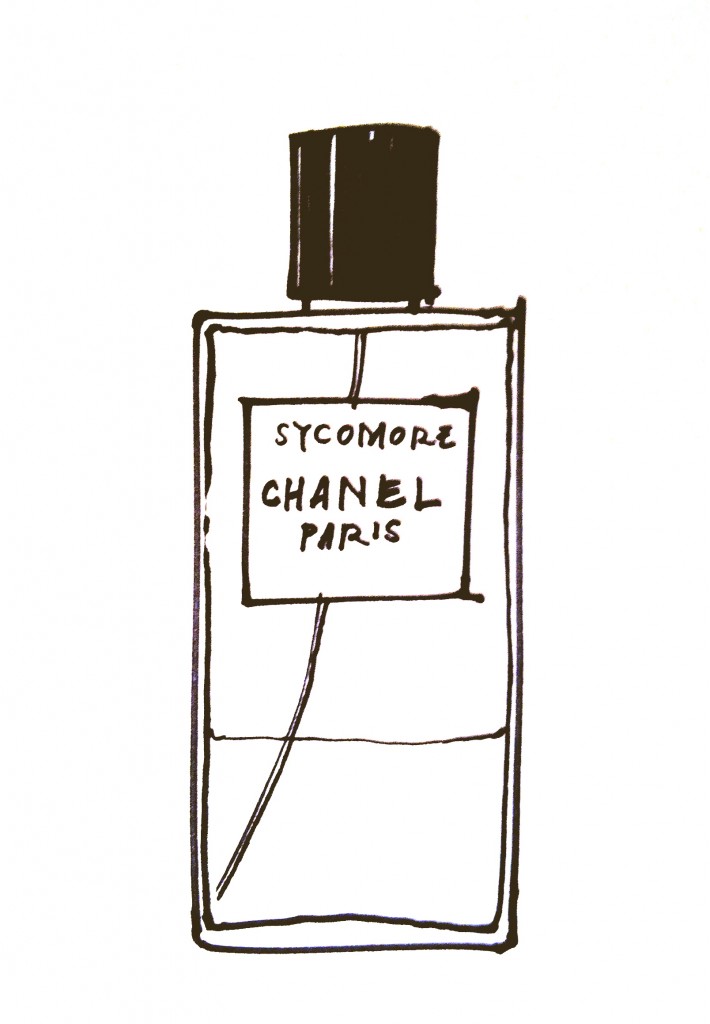 Until recently, Sycomore was one of the most extraordinary perfumes that I know (see note, below). OK, its name looks like a misspelling of sycamore, a tree that – in Britain at least – no right-minded person would name a fragrance after. Sycamores, after all, are as common as muck, breed like rabbits and are often looked down on by ecologists as they’re not even native trees.
Until recently, Sycomore was one of the most extraordinary perfumes that I know (see note, below). OK, its name looks like a misspelling of sycamore, a tree that – in Britain at least – no right-minded person would name a fragrance after. Sycamores, after all, are as common as muck, breed like rabbits and are often looked down on by ecologists as they’re not even native trees.
Acer pseudoplatanus, to give the tree its proper botanical name, is also responsible for many of those deeply irritating ‘leaves on the line’ excuses that railway companies give out each autumn to explain why their trains are running late. Worst of all, from a perfume perspective, they don’t even really smell of much, though their leaves do have the faintest leathery scent and their wood, once dried enough, burns with a pretty generic woodsmoke smell.
So is Sycomore just an example of misguided marketing, like Ralph Lauren’s dreadfully named Glamourous? Actually, no. Coming from arguably the world’s most tightly policed brand, its name will have been very carefully considered – and actually it almost certainly refers not, as I’d initially thought, to Acer pseudoplatanus at all but to a rather more exotic tree, the so-called Sycomore fig.
Ficus sycomorus (to use its Latin name) is a large, spreading tree that grows across central Africa and the Middle East, where its heavy shade is much appreciated; it was known to the Egyptians as the Tree of Life. It’s a tree I haven’t sniffed, but my guess is that it shares at least some of the dry, green, slightly fruity scent that we know from other varieties of fig – though ironically there’s only the faintest hint of figginess in Sycomore.
Anyhow, enough about the name. What makes Sycomore extraordinary, for me, is a trick it seems to be able to do that no other perfume I’ve come across seems to be able to do. This is to smell like two completely different scents, depending on whether you smell it close up or at a distance. Up close it has the strong, earthy, pleasantly bitter scent of vetiver, the root of an Indian grass that’s related to lemongrass and citronella. It’s also grown commercially in the Caribbean, and apparently Chanel’s super-high-quality vetiver originated in Haiti.
Vetiver is usually classed as one of the great masculine fragrances, presumably because of its bracing bitterness and lack of cloying sweetness; it’s certainly not a flowery smell. But it also has a warmth and – get this – a touch of smokiness that gives it extra depth and complexity, especially when it’s surrounded by such a delicious cushion of other scents, which mix smokiness with a slightly sweeter touch of fruit. Vetiver is also famous for its staying power, and a spritz of Sycomore can last you all day.
It’s the added fruitiness that, on occasion, one gets a whiff of when someone wearing Sycomore strolls by, and then it’s like a different, warmer, sweeter fragrance altogether, with hardly a hint of the vetiver that dominates the perfume on the skin. If it’s an intentional trick I’m in awe, though it seems perfectly possible, given that Sycomore was created by Chanel’s chief nose Jacques Polge in collaboration with Christopher Sheldrake, the legendary British perfumer who has been Chanel’s director of research and development since 2005.
Like the other fragrances that belong to Les Exclusifs de Chanel, Sycomore costs about twice as much as your average perfume, but it does come in a typically (for Chanel) handsome bottle, beautifully presented in a chunky white-and-black box. The hidden magnet in the heavy black cap, ensuring that the iconic twin Cs of the Chanel logo always end up perfectly aligned, is a particularly nice touch, even if it has since been adopted by one or two other brands.
Though it’s a classically masculine scent Sycomore is (quite rightly) marketed as a unisex fragrance, and like most men’s perfumes it can smell wonderful on a woman. Yet what I love most is that, from the very first sniff, it has a wonderful feeling of luxury, quality and depth, which are things that are all too often lacking in other perfumes. And who could resist its baffling cleverness, like a cryptic crossword in scent?
Autumn 2016 update. Oh dear: evidently Sycomore hasn’t been a commercial success, as Chanel have recently ‘updated’ it, and now – minus the fruitiness that made it so unusual – it’s a perfectly pleasant, fairly straight-up vetiver. From being unique it’s become one of many. Such a shame – another great perfume gone.
Christian Dior
Dior Homme
19 May, 2014
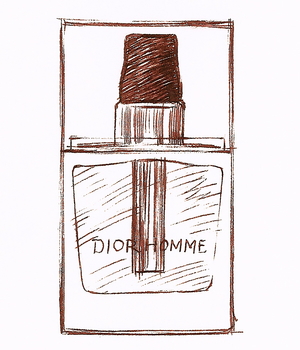 We all have blind spots, and Dior Homme has definitely been one of mine. I was, very kindly, given a bottle some time ago, and I admired its clear glass-and-lucite design, but as for the perfume inside – I just didn’t get it. It had excellent reviews, and it obviously sells well, so I thought I’d better give it another try.
We all have blind spots, and Dior Homme has definitely been one of mine. I was, very kindly, given a bottle some time ago, and I admired its clear glass-and-lucite design, but as for the perfume inside – I just didn’t get it. It had excellent reviews, and it obviously sells well, so I thought I’d better give it another try.
Still no luck, I’m afraid. It’s not horrible (which is a rarer attribute than you might expect), but neither does it make me go ‘WOW!’, which is the response I’m always hoping for. There’s a hint of something in it that I really don’t like, which it shares with a lot of other men’s fragrances today – a slightly metallic, chemical smell, which might come from dihydromyrcenol or perhaps from ISO E Super, both (ab)used with gay abandon by contemporary perfumers.
So why the brilliant reviews? Am I just completely missing something? Actually, I suspect not. Although it was only launched in 2005, it seems that the original scent might well have been tinkered with and reformulated (quite possibly more than once), meaning that the bottle I have probably smells very little like the much-admired original. Which is a shame, as it did sound very appealing, not least because it was created by the talented Olivier Polge, son of Chanel’s legendary in-house perfumer Jacques Polge.
Whatever the truth of the matter, the version I have and the original do seem to share at least one interesting quality. I’ve pointed out before that in itself perfume is genderless – how can a liquid be ‘masculine’ or ‘feminine’? But there are definitely some ingredients and effects that, at least historically, have been more closely associated with women or men. Vetiver, for example, is considered a classic ‘male’ smell, while iris is widely regarded as and ‘feminine’ and ‘floral’ (even though the scent is extracted not from iris flowers but from its roots).
As its name far from subtly suggests, Dior Homme is aimed squarely at men, yet its main smell, even in my rather synthetic-smelling version, derives from iris; compare it with Chanel’s superlative 1932 and you’ll see what I mean. Either this shows that contemporary men are more sophisticated than some might say, or they’re dumb enough to believe anything they’re sold. I like to think the former, but maybe I’m deluding myself; what do you think?